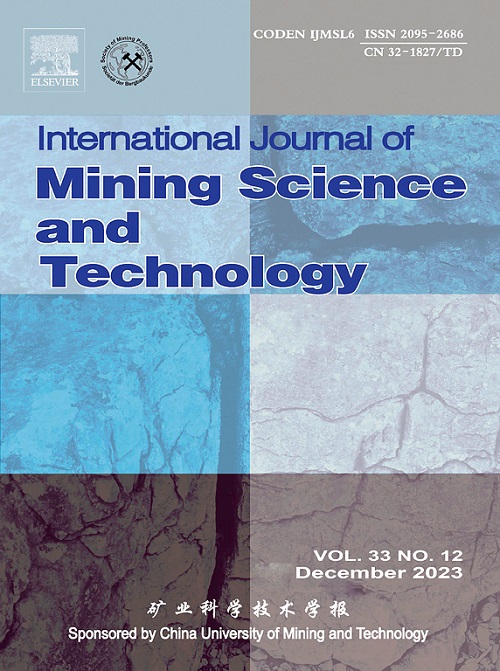利用低品位盐矿的沉积物空隙进行压缩空气储能:实验和理论见解
IF 13.7
1区 工程技术
Q1 MINING & MINERAL PROCESSING
International Journal of Mining Science and Technology
Pub Date : 2025-08-01
DOI:10.1016/j.ijmst.2025.07.001
引用次数: 0
摘要
可再生能源存储技术对于向可持续能源系统过渡至关重要,盐穴在大规模解决方案中发挥着重要作用。在低品位盐层的水溶性开采中,不溶性杂质和夹层在盐溶蚀过程中分离,并在盐洞底部沉积,从而降低了盐洞储气库的储存量和经济可行性。以淮安低品位盐矿为研究对象,研究了低品位盐矿的沉积物形成机制、孔隙分布和孔隙度,并介绍了自行研制的模拟两井水平井洞室的物理模拟装置,模拟了注压缩空气和排盐过程。对比“一注一排”和“两注一排”两种模式的实验结果表明:(1)压缩空气有效地置换了沉积物空隙中的盐水;(2)0.5 MPa注入压力对应于10.3 MPa的实际操作下限,与现场数据一致;(3)通过气-盐水界面理论验证了沉积物空隙率约为46%。“两注一放”方式在排量和排量上均优于“两注一放”方式。此外,建立了压缩空气驱盐的数学模型。这些研究结果为优化低品位盐矿压缩空气储能系统,推进其在可再生能源整合中的作用提供了基础见解。本文章由计算机程序翻译,如有差异,请以英文原文为准。
Harnessing sediment voids of low-grade salt mines for compressed air energy storage: Experimental and theoretical insights
Renewable energy storage technologies are critical for transitioning to sustainable energy systems, with salt caverns playing a significant role in large-scale solutions. In water-soluble mining of low-grade salt formations, insoluble impurities and interlayers detach during salt dissolution and accumulate as sediment at the cavern base, thereby reducing the storage capacity and economic viability of salt cavern gas storage (SCGS). This study investigates sediment formation mechanisms, void distribution, and voidage in the Huai’an low-grade salt mine, introducing a novel self-developed physical simulation device for two butted-well horizontal (TWH) caverns that replicates compressed air injection and brine discharge. Experiments comparing “one injection and one discharge” and “two injections and one discharge” modes revealed that (1) compressed air effectively displaces brine from sediment voids, (2) a 0.5 MPa injection pressure corresponds to a 10.3 MPa operational lower limit in practice, aligning with field data, and (3) sediment voidage is approximately 46%, validated via air-brine interface theory. The “two injections and one discharge” mode outperformed in both discharge volume and rate. Additionally, a mathematical model for brine displacement via compressed air was established. These results provide foundational insights for optimizing compressed air energy storage (CAES) in low-grade salt mines, advancing their role in renewable energy integration.
求助全文
通过发布文献求助,成功后即可免费获取论文全文。
去求助
来源期刊

International Journal of Mining Science and Technology
Earth and Planetary Sciences-Geotechnical Engineering and Engineering Geology
CiteScore
19.10
自引率
11.90%
发文量
2541
审稿时长
44 days
期刊介绍:
The International Journal of Mining Science and Technology, founded in 1990 as the Journal of China University of Mining and Technology, is a monthly English-language journal. It publishes original research papers and high-quality reviews that explore the latest advancements in theories, methodologies, and applications within the realm of mining sciences and technologies. The journal serves as an international exchange forum for readers and authors worldwide involved in mining sciences and technologies. All papers undergo a peer-review process and meticulous editing by specialists and authorities, with the entire submission-to-publication process conducted electronically.
 求助内容:
求助内容: 应助结果提醒方式:
应助结果提醒方式:


